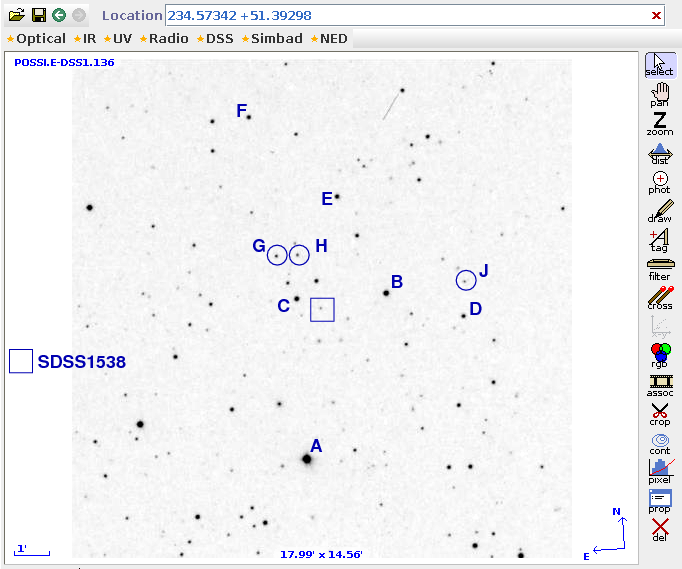
On the night of May 05/06, 2013, I measured for the second time the cataclysmic variable known as SDSSJ1538+5123. The Hubble Space Telescope will observe this object later this month (May 16-17), so it's important to monitor its brightness.
The setup was:
Notes from the night
This is a chart of the field of SDSSJ1538, taken from Aladin and the POSS I E plate. The target is in the square box near the middle of the field.

You can find information on the star, including a photometric sequence of comparison stars nearby, at the AAVSO's entry for SDSS1538 in the International Variable Star index.
AUID letter RA. Dec. B V B-V ------------------------------------------------------------------------------------------ 000-BJR-224 A 15:38:51.06 51:20:37.2 13.186 (0.077) 12.617 (0.061) 0.569 (0.098) 000-BJR-225 B 15:38:05.33 51:23:57.9 13.998 (0.006) 13.343 (0.006) 0.655 (0.008) 000-BJR-226 C 15:38:21.62 51:23:55.9 14.756 (0.008) 14.170 (0.008) 0.586 (0.011) 000-BJR-227 E 15:38:13.33 51:26:46.1 15.843 (0.010) 15.082 (0.010) 0.761 (0.014) 000-BJR-228 F 15:38:28.57 51:29:09.1 15.820 (0.004) 15.295 (0.000) 0.525 (0.004) 000-BJR-229 D 15:37:51.56 51:23:10.8 16.732 (0.017) 15.691 (0.017) 1.041 (0.024) 000-BJR-230 15:38:37.21 51:23:54.9 16.670 (0.010) 16.161 (0.008) 0.509 (0.013) 000-BJR-231 15:37:58.24 51:27:07.2 17.283 (0.011) 16.443 (0.008) 0.840 (0.014) 000-BJR-232 15:38:39.75 51:25:36.2 17.897 (0.022) 17.117 (0.011) 0.780 (0.025) 000-BJR-233 G 15:38:24.80 51:25:11 18.194 (0.036) 17.360 (0.008) 0.834 (0.037) 000-BJR-234 H 15:38:21.08 51:25:10.8 18.777 (0.047) 17.864 (0.000) 0.913 (0.047) 000-BJR-235 J 15:37:50.99 51:24:10.5 18.951 (0.025) 18.265 (0.008) 0.686 (0.026) ------------------------------------------------------------------------------------------ Report this sequence as: 11711AGH in the chart field of your observation report.The brightest star, marked "Q", is UCAC4-707-053459, and has magnitude V = 10.77. The target, SDSS1538, is much fainter, with a magnitude in quiescence of roughly V = 18.
Tonight, I planned to acquire images with the clear filter (again) but also with the V-band filter. I took twilight sky flats in both filters; if using both V and I, remember that the better sequence for twilight sky flats is _first_ I, then V.
I again guided the telescope using a nearby star. As explained in the notes from last night , the telescope doesn't move smoothly in Dec, so a few exposures suffered from jumps. I discarded those -- they amounted to just a few percent of the total.
I took two series of images:
Stack of (21 x 60 seconds) with clear filter (left), and (71 x 60 seconds) with V filter (right).


Using aperture photometry with a radius of 4 pixels (radius of 7.4 arcsec), I measured the instrumental magnitudes of a number of reference stars and the target. There are two ways to estimate the magnitude of SDSS 1538.
V = (instr. clear mag) + 0.26 +/- 0.05 mag
V = (instr. V mag) - 1.34 +/- 0.02 mag
from which we can derive
SDSS 1538 "V" (based on clear) = 18.7 +/- 0.2
SDSS 1538 V (based on my V ) = 18.6 +/- 0.3
V = (instr. clear mag) + 0.017 + 0.3026 * (B-V) +/- 0.02
V = (instr. V mag) - 1.257 - 0.0985 * (B-V) +/- 0.02
from which we can derive
SDSS 1538 "V" (based on clear) = 18.4 +/- 0.2
SDSS 1538 V (based on my V ) = 18.7 +/- 0.3
I'm going to conclude that V = 18.7 +/- 0.2 from these measurements.
Let me summarize my results:
# Measurements of SDSS 1538+5123 # made by Michael Richmond at the RIT Observatory # with 12-inch Meade LX200 + SBIG ST-8E CCD. # V filter, stacked (71 x 120-second) exposure # Conditions were good: clear, dark skies. # # Aperture photometry with radius 4 pix = 7.4 arcsec. # Reference star photometry from AAVSO chart 11713LT # "V" mag is based on V-band measurements, # compared to V-band reference magnitudes, (B-V) color terms. # # UT Date mid-UT JD V mag #---------------------------------------------- 2013 May 06 03:04 2456418.63 18.7 +/- 0.2
Last modified 05/06/2013 by MWR.